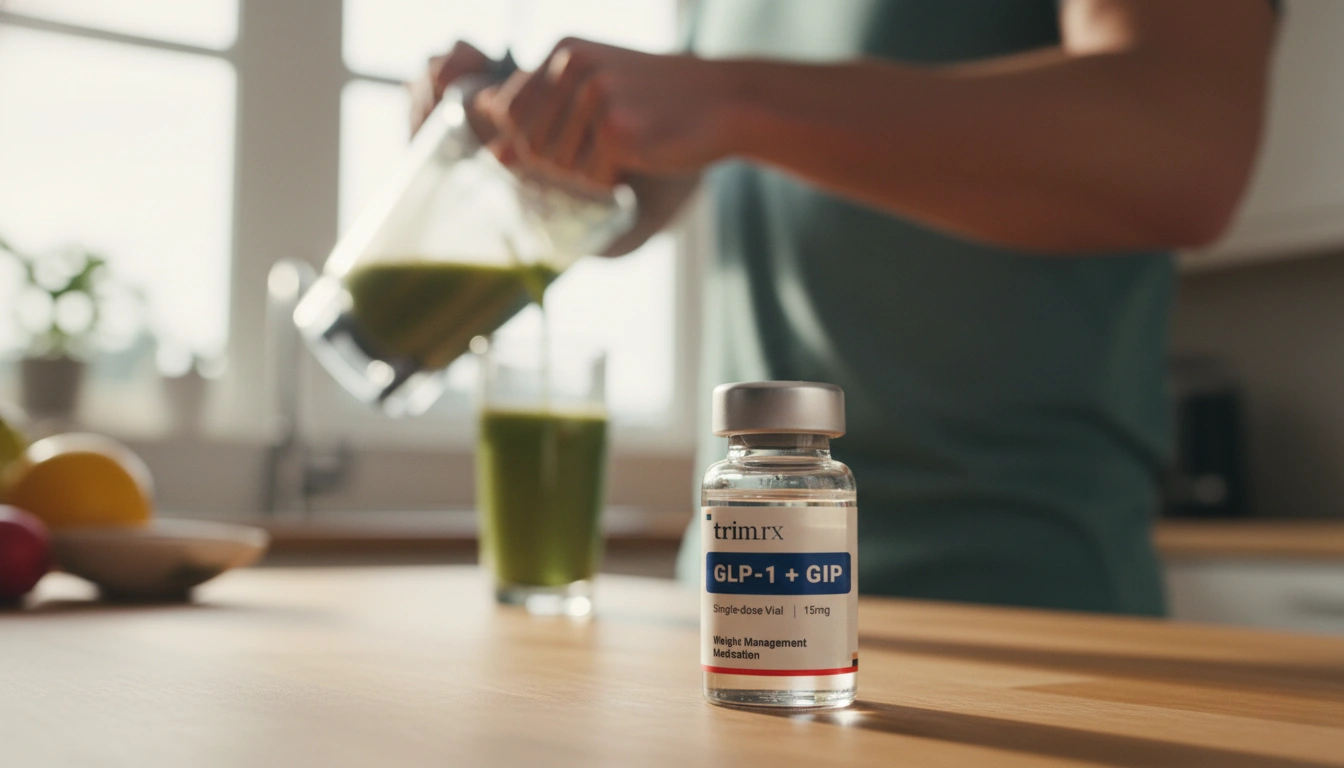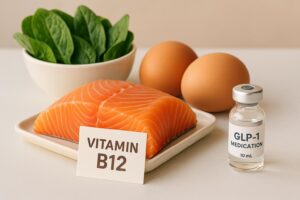How to Increase GLP-1 Production Naturally for Effective Weight Management

Have you ever wondered why some people seem to have an easier time managing their weight and controlling their appetites than others? The answer may lie within a remarkable hormone known as glucagon-like peptide-1 (GLP-1). This hormone, primarily produced in the intestines, plays a pivotal role in regulating appetite, blood sugar levels, and overall metabolic health.
In recent years, GLP-1 has garnered increasing attention due to its pivotal role in weight loss and diabetes management. As we navigate the complexities of our health journeys, learning how to increase GLP-1 production naturally can be a game changer. This blog post will explore effective strategies for enhancing GLP-1 levels, the significance of a healthy gut microbiome, and how these practices can lead to sustainable weight management.
Together, we’ll delve into the science behind GLP-1, identify foods and lifestyle changes that may boost its production, and ultimately empower you on your journey toward better health.
Introduction
GLP-1 is a hormone that acts like a conductor in the symphony of our metabolic processes. It is released from the gut in response to food intake and serves multiple functions: it stimulates insulin secretion, slows gastric emptying, and signals satiety to the brain. Research indicates that individuals with obesity often experience lower levels of this crucial hormone, which can significantly impact their ability to manage their weight and hunger cues.
As the popularity of GLP-1 receptor agonists, such as semaglutide (Ozempic, Wegovy) and tirzepatide (Mounjaro, Zepbound), has surged, so too has interest in natural methods to enhance GLP-1 production. This blog will provide insights into how we can support the body’s natural mechanisms for producing GLP-1 through dietary choices and lifestyle adjustments.
By the end of this article, you’ll have a comprehensive understanding of the relationship between GLP-1 and weight management, along with actionable steps to incorporate these practices into your daily routine. Let’s explore how we can harness the power of GLP-1 for improved health and well-being.
Understanding GLP-1: The Role It Plays in Metabolism
To appreciate the significance of GLP-1, it’s essential to understand what it is and how it functions within our bodies. GLP-1 is an incretin hormone secreted by the L-cells in the intestine. Its primary roles include:
-
Stimulating Insulin Secretion: After we eat, GLP-1 enhances the secretion of insulin from the pancreas, helping regulate blood sugar levels.
-
Slowing Gastric Emptying: GLP-1 slows down the rate at which food leaves the stomach, contributing to a feeling of fullness and preventing spikes in blood sugar.
-
Reducing Hunger: By signaling the brain that we are full, GLP-1 helps regulate appetite and food intake, which can be particularly beneficial for those looking to lose weight.
-
Inhibiting Glucagon Release: GLP-1 also suppresses the release of glucagon, a hormone that raises blood sugar levels, further aiding in blood sugar management.
Despite its importance, many individuals—especially those with obesity or metabolic disorders—struggle with inadequate GLP-1 levels. This underscores the value of finding ways to increase GLP-1 production naturally.
Dietary Choices That Boost GLP-1 Production
Our dietary choices significantly impact GLP-1 levels. Certain foods are particularly effective at stimulating GLP-1 secretion due to their nutrient composition. Let’s explore these foods and how they can contribute to enhancing GLP-1 production.
High-Fiber Foods
Fiber is a key player in boosting GLP-1 levels. When we consume fiber-rich foods, they undergo fermentation in the gut, leading to the production of short-chain fatty acids (SCFAs) that stimulate GLP-1 secretion. Some effective fiber sources include:
- Whole Grains: Foods like oats, barley, and quinoa are excellent sources of soluble fiber that can enhance GLP-1 production.
- Legumes: Beans, lentils, and chickpeas provide both fiber and protein, making them a great addition to meals.
- Fruits and Vegetables: High-fiber options such as apples, pears, broccoli, and Brussels sprouts promote gut health and stimulate GLP-1 release.
Healthy Fats
Incorporating healthy fats into our diet not only supports overall health but also aids in GLP-1 production. Foods rich in unsaturated fats, such as:
- Avocados: They are packed with fiber and monounsaturated fats, both of which can enhance GLP-1 levels.
- Nuts and Seeds: Almonds, walnuts, and flaxseeds provide healthy fats and fiber, contributing to increased GLP-1 production.
- Olive Oil: This healthy fat can help stimulate GLP-1 release and improve insulin sensitivity.
Protein Sources
High-protein foods can also promote GLP-1 secretion. Notably:
- Eggs: A protein-rich food that has been shown to increase GLP-1 levels while enhancing satiety.
- Lean Meat and Fish: These protein sources help regulate appetite and contribute to nutrient balance in meals.
Prebiotics and Probiotics
Maintaining a healthy gut microbiome is crucial for GLP-1 production. Prebiotic foods feed beneficial gut bacteria, promoting the fermentation process that leads to SCFA production. Some prebiotic-rich foods include:
- Garlic and Onions: These foods contain inulin, a type of prebiotic fiber that enhances gut health.
- Bananas: They contain fructooligosaccharides that support gut bacteria and promote GLP-1 secretion.
Probiotics, found in fermented foods like yogurt, kefir, sauerkraut, and kimchi, can also play a role in enhancing GLP-1 levels by supporting a balanced gut microbiome.
Summary of Dietary Choices
To summarize, incorporating high-fiber foods, healthy fats, and protein sources into our diets can significantly boost GLP-1 production. By focusing on whole, nutrient-dense foods, we can support our metabolic health and appetite regulation.
Lifestyle Changes to Support GLP-1 Production
Beyond dietary choices, several lifestyle factors can influence GLP-1 levels. Let’s explore these strategies that can enhance GLP-1 production naturally.
Regular Physical Activity
Exercise is a powerful tool for improving metabolic health and increasing GLP-1 levels. Research suggests that both aerobic and resistance training can enhance GLP-1 secretion. Engaging in regular physical activity can improve insulin sensitivity, promote weight loss, and support overall metabolic function.
For optimal results, we should aim for at least 150 minutes of moderate-intensity exercise per week, including cardiovascular activities and strength training.
Stress Management
Chronic stress can have a negative impact on our hormones, including GLP-1. High levels of stress hormones, such as cortisol, can inhibit GLP-1 secretion and lead to increased appetite.
Implementing stress-reducing practices, such as mindfulness, meditation, yoga, or even simple breathing exercises, can help manage stress levels and promote hormonal balance, ultimately supporting GLP-1 production.
Quality Sleep
Sleep is a critical component of our overall health and well-being. Poor sleep quality can disrupt hormone regulation, including GLP-1 levels.
Prioritizing good sleep hygiene, such as maintaining a regular sleep schedule, creating a restful sleep environment, and limiting screen time before bed, can help improve sleep quality and support metabolic health.
Summary of Lifestyle Changes
Incorporating regular physical activity, managing stress effectively, and prioritizing quality sleep can significantly enhance GLP-1 production and contribute to better health outcomes.
The Importance of a Healthy Gut Microbiome
The gut microbiome plays a critical role in GLP-1 production and overall metabolic health. Research has shown that the diversity and composition of gut bacteria can influence GLP-1 secretion. Here, we will explore how to support gut health to enhance GLP-1 levels.
Promoting Gut Diversity
A diverse gut microbiome is associated with better metabolic health and increased GLP-1 production. To promote gut diversity:
- Eat a Variety of Foods: Including different fruits, vegetables, whole grains, and protein sources can help cultivate a diverse gut microbiome.
- Limit Processed Foods: Highly processed foods can negatively impact gut health, so focusing on whole foods is essential.
Incorporating Fermented Foods
Fermented foods are rich in probiotics, which can help maintain a balanced gut microbiome. Including options such as:
- Yogurt and Kefir: These dairy products are excellent sources of live bacteria that can support gut health.
- Sauerkraut and Kimchi: These fermented vegetables provide beneficial probiotics and fiber.
Summary of Gut Health Promotion
Fostering a healthy gut microbiome through diverse dietary choices and the incorporation of fermented foods can enhance GLP-1 production and improve metabolic health.
Conclusion
Increasing GLP-1 production naturally is not only achievable but also essential for effective weight management and overall health. By making informed dietary choices, incorporating healthy lifestyle practices, and supporting gut health, we can harness the power of GLP-1 to regulate appetite and improve metabolic function.
At TrimRx, we believe in the power of personalized approaches to health, which includes understanding how our bodies respond to various foods and lifestyle changes. If you’re interested in exploring more about weight management and personalized solutions, we invite you to take our free assessment quiz to see if you qualify for our prescription weight loss medications. Together, we can embark on a journey toward better health and sustainable weight loss.
FAQ
What foods should I eat to increase GLP-1 production?
Foods rich in fiber, healthy fats, and protein are essential for boosting GLP-1 levels. Opt for whole grains, legumes, fruits, vegetables, nuts, seeds, and lean proteins.
Can exercise help increase GLP-1 levels?
Yes, regular physical activity, including both aerobic and resistance training, has been shown to enhance GLP-1 secretion and improve metabolic health.
How does stress affect GLP-1 production?
Chronic stress can inhibit GLP-1 secretion due to elevated cortisol levels. Managing stress through mindfulness and relaxation techniques can support GLP-1 production.
Why is gut health important for GLP-1 production?
A diverse and balanced gut microbiome promotes GLP-1 secretion. Including prebiotics and probiotics in your diet can enhance gut health and support GLP-1 levels.
How can I start increasing my GLP-1 levels naturally?
Begin by incorporating fiber-rich foods, healthy fats, and protein sources into your diet. Additionally, engage in regular exercise, manage stress, and prioritize quality sleep for optimal results.
By following these guidelines, we can elevate our health and enhance our weight management efforts through the natural increase of GLP-1 production.

Transforming Lives, One Step at a Time
Keep reading
Vitamin B12 and GLP-1 Medications: What to Know
GLP-1 medications can lower B12 absorption and intake; learn symptoms, food sources, supplement options, and how to monitor levels.
Semaglutide Injection Site Reactions: What To Know
Learn why semaglutide injections can cause redness, swelling or nodules, how to prevent and treat them, and when to seek medical care.
TrimRx vs Friday’s
Compare TrimRx and Friday’s telehealth GLP-1 weight-loss programs: pricing, medical support, coaching, delivery, and which fits your needs.



